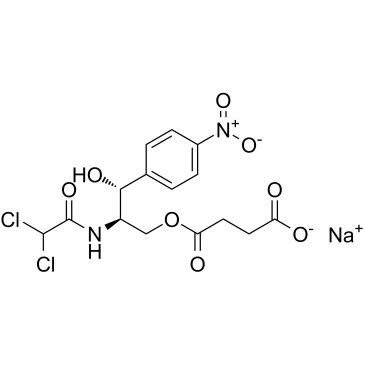Chloramphenicol succinate sodium (CCRIS6204; CCRIS-6204) is an antibiotic and a prodrug of Chloramphenicol with Haemotoxicity, as Chloramphenicol succinate is a competitive substrate and inhibitor of succinate dehydrogenase (SDH).
Physicochemical Properties
| Molecular Formula | C₁₅H₁₅CL₂N₂NAO₈ |
| Molecular Weight | 445.18 |
| Exact Mass | 444.01 |
| Elemental Analysis | C, 40.47; H, 3.40; Cl, 15.93; N, 6.29; Na, 5.16; O, 28.75 |
| CAS # | 982-57-0 |
| Related CAS # | Chloramphenicol succinate;3544-94-3 |
| PubChem CID | 656833 |
| Appearance | White to light yellow solid powder |
| Boiling Point | 716.3ºC at 760mmHg |
| Flash Point | 387ºC |
| LogP | 0.904 |
| Hydrogen Bond Donor Count | 2 |
| Hydrogen Bond Acceptor Count | 8 |
| Rotatable Bond Count | 9 |
| Heavy Atom Count | 28 |
| Complexity | 541 |
| Defined Atom Stereocenter Count | 2 |
| SMILES | [Na+].OC(CCC(OC[C@H]([C@@H](C1=CC=C([N+]([O-])=O)C=C1)O)NC(C(Cl)Cl)=O)=O)=O |
| InChi Key | RPLOPBHEZLFENN-HTMVYDOJSA-M |
| InChi Code | InChI=1S/C15H16Cl2N2O8.Na/c16-14(17)15(24)18-10(7-27-12(22)6-5-11(20)21)13(23)8-1-3-9(4-2-8)19(25)26/h1-4,10,13-14,23H,5-7H2,(H,18,24)(H,20,21)/q+1/p-1/t10-,13-/m1./s1 |
| Chemical Name | sodium 4-((2R,3R)-2-(2,2-dichloroacetamido)-3-hydroxy-3-(4-nitrophenyl)propoxy)-4-oxobutanoate |
| Synonyms | Chloramphenicol sodium succinate; CCRIS6204; CCRIS-6204; CCRIS 6204 |
| HS Tariff Code | 2934.99.9001 |
| Storage |
Powder-20°C 3 years 4°C 2 years In solvent -80°C 6 months -20°C 1 month Note: This product requires protection from light (avoid light exposure) during transportation and storage. |
| Shipping Condition | Room temperature (This product is stable at ambient temperature for a few days during ordinary shipping and time spent in Customs) |
Biological Activity
| References |
[1].Ambrose PJ. Clinical pharmacokinetics of chloramphenicol and chloramphenicol succinate. Clin Pharmacokinet. 1984 May-Jun;9(3):222-38. [2].Ambekar CS, et al. Chloramphenicol succinate, a competitive substrate and inhibitor of succinate dehydrogenase: possible reason for its toxicity. Toxicol In Vitro. 2004 Aug;18(4):441-7. [3].Turton JA, et al. Haemotoxicity of chloramphenicol succinate in the CD-1 mouse and Wistar Hanover rat. Hum Exp Toxicol. 1999 Sep;18(9):566-76 |
| Additional Infomation |
Chloramphenicol Sodium Succinate can cause cancer according to state or federal government labeling requirements. Chloramphenicol sodium succinate is a white powder. (NTP, 1992) Chloramphenicol Sodium Succinate is the sodium succinate salt form of chloramphenicol, a nitrobenzene derivate and broad-spectrum antibiotic with antibacterial activity. Chloramphenicol sodium succinate reversibly binds to the 50S subunit of bacterial ribosomes, thereby interfering with peptidyl transferase activity in the elongation process of protein synthesis. As a result, this agent prevents bacterial cell growth. See also: Chloramphenicol (broader). |
Solubility Data
| Solubility (In Vitro) |
DMSO : ~125 mg/mL (~280.79 mM) H2O : ~50 mg/mL (~112.31 mM) |
| Solubility (In Vivo) |
Solubility in Formulation 1: ≥ 2.08 mg/mL (4.67 mM) (saturation unknown) in 10% DMSO + 40% PEG300 + 5% Tween80 + 45% Saline (add these co-solvents sequentially from left to right, and one by one), clear solution. For example, if 1 mL of working solution is to be prepared, you can add 100 μL of 20.8 mg/mL clear DMSO stock solution to 400 μL PEG300 and mix evenly; then add 50 μL Tween-80 to the above solution and mix evenly; then add 450 μL normal saline to adjust the volume to 1 mL. Preparation of saline: Dissolve 0.9 g of sodium chloride in 100 mL ddH₂ O to obtain a clear solution. Solubility in Formulation 2: ≥ 2.08 mg/mL (4.67 mM) (saturation unknown) in 10% DMSO + 90% (20% SBE-β-CD in Saline) (add these co-solvents sequentially from left to right, and one by one), clear solution. For example, if 1 mL of working solution is to be prepared, you can add 100 μL of 20.8 mg/mL clear DMSO stock solution to 900 μL of 20% SBE-β-CD physiological saline solution and mix evenly. Preparation of 20% SBE-β-CD in Saline (4°C,1 week): Dissolve 2 g SBE-β-CD in 10 mL saline to obtain a clear solution. Solubility in Formulation 3: ≥ 2.08 mg/mL (4.67 mM) (saturation unknown) in 10% DMSO + 90% Corn Oil (add these co-solvents sequentially from left to right, and one by one), clear solution. For example, if 1 mL of working solution is to be prepared, you can add 100 μL of 20.8 mg/mL clear DMSO stock solution to 900 μL of corn oil and mix evenly. Solubility in Formulation 4: 100 mg/mL (224.63 mM) in PBS (add these co-solvents sequentially from left to right, and one by one), clear solution; with ultrasonication. (Please use freshly prepared in vivo formulations for optimal results.) |
| Preparing Stock Solutions | 1 mg | 5 mg | 10 mg | |
| 1 mM | 2.2463 mL | 11.2314 mL | 22.4628 mL | |
| 5 mM | 0.4493 mL | 2.2463 mL | 4.4926 mL | |
| 10 mM | 0.2246 mL | 1.1231 mL | 2.2463 mL |
